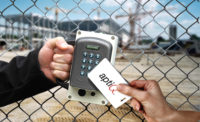Ionization and photoelectric are two types of detectors. Ionization detectors use a small amount of radioactive material to trigger a fire alarm. These types of detectors are used most commonly in homes because they are relatively inexpensive. Although both types of detectors have strengths, many manufacturers and dealers encourage the use of photoelectric smoke detectors.
“Ask any alarm dealer in the country what type of detector they install and he will tell you photoelectric,†insists Richard Cantor, CEO of Amerigard Security. Although ionization smoke detectors react quickly to flame, they typically take longer to detect a smoldering fire, which is the most common type to occur in homes, asserts Brad Barnes, marketing integration leader for GE Security.
Photoelectric detectors are more sensitive to smoldering fires and have a greater chance of detecting a fire much earlier than ionization detectors.
Another trend dealers are seeing in initiating devices is multi-sensor technology, such as combining heat and photoelectric detection in one unit, Barnes says. These types of systems may be viable replacements for ionization detectors, he adds.
Other initiating devices have built-in sounders so separate installation of horns and sirens may be unnecessary. A useful technology for installers and end-users alike is built-in notification of when a device may be dirty or may have collected too much dust. Such a problem can cause false alarms.
Drift compensation is a useful option that also can help prevent false alarms. This feature compensates for detector contamination and maintains the desired sensitivity level of the device.
Wiring is another consideration for technicians. Devices available in two- and four-wire configurations and with retrofit capabilities can help installers cover a wide variety of applications. Pull stations offer weatherproof options and different colors.
In addition to choices and easy installation, dealers praise manufacturers for offering comprehensive customer service, backup and training.
So what is the best fit for you? In an effort to narrow down your choices, SDM highlights several major manufacturers’ latest initiating devices along with reasons why their customers choose them.
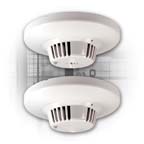
Bosch Security Systems
Bosch Security Systems’ F220 series smoke detectors include a photoelectric model (F220-P) and a photoelectric model with heat detection (F220-PTH). Users can clean the detectors without disassembling the devices.To save time, this ChamberMaid feature allows installers or users to clean the chamber through a port on the rear of the detector with canned air. The detectors automatically compensate sensitivity for contamination in the chamber, thereby reducing false alarms and extending the time between cleaning.
A dual-screen LED indicates whether the detector is operating normally. Both two- and four-wire bases and a separately powered sounder version are available to cover most applications. CleanMe sensitivity allows the detector to send a signal to an enabled control panel, letting it know when the detector needs cleaning.
What the customer had to say:
Chris Mosley, president of Complete Security Systems Inc., Marlboro, N.J., points to several reasons why his company uses Bosch products exclusively. “We believe it’s a high-level, high-quality product,†Mosley declares. He is happy with the technical support his company gets from Bosch.
“[Bosch products are] very flexible and user-friendly,†he says. “The F220 can be used in two different voltages, which is nice.†In addition, Mosley points to the availability of the Bosch products to his company and the price point – two important considerations for alarm dealers and distributors.
“The equipment is user-friendly for both the technicians and end users. Also, the training Bosch provides to us is very thorough.†– Chris Mosley, president, Complete Security Systems Inc.
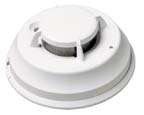
Digital Security Controls (DSC)
The FSA-210 series of photoelectric smoke detectors provide drift compensation. They automatically compensate to maintain the detector’s original, factory-set sensitivity as dust accumulates. This two-wire series has optional built-in, dual-sensor heat detectors and built-in 85 dB horns. These provide better protection for any type of fire and can eliminate the need for separate horns. Installers and end-users may like the removable chamber for easy maintenance and non-contact sensitivity testing with the company’s FSD-100 handheld test meter.DSC’s four-wire photoelectric smoke detectors are available in the FSA-410 series. Similar to the 210 series, the detectors offer drift compensation, optional dual-sensor heat detection and built-in horns, removable chambers and non-contact sensitivity testing capabilities. Both series of smoke detectors feature local test buttons, compatibility with all DSC control panels and are UL-, ULC-, CSFM- and MEA-listed for commercial and residential applications.
What the customer had to say:
Ranger American, Dallas, almost exclusively uses DSC products for their security applications, reports Burke Yates, director of quality process for the company. “We’ve used DSC for a very long time. They are an exceptionally good manufacturer and the product is exceptionally reliable,†Yates says.
He points to DSC’s two- and four-wire detector options as particularly useful for all applications. “The product selection is easy and installer friendly,†he adds. In addition, options such as dual-sensor detectors and built-in horns can meet the needs of any installation application, Yates notes.
“DSC has brought to the table many technological advancements – they are installer- and user-friendly.†– Burke Yates, director of quality process, Ranger American
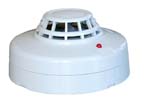
Edwards Systems Technology
The EC series smoke and heat detectors are designed for small building installations. A sensitivity unit is available and removable housings make maintenance simple. The EC series heat detectors have electronic thermistor technology. The EC30U-3 is a photoelectric optical detector, which is particularly reliable for slow-burning fires.The EC20RRU-3 rate-of-rise detector is useful for applications where the ambient temperature is relatively constant, but steam and smoke are present, such as kitchens or bathrooms. For fluctuating ambient temperatures, the EC20FTU-3 fixed-temperature detector is ideal. If a detector is removed for any reason while the panel is in a normal state, a zone-trouble condition will result, thereby ensuring the integrity of the alarm system at all times.
Signature series detectors from Edwards Systems Technology offer digital multi-sensor detection for reliability. A built-in microprocessor constantly monitors the state of its sensors, adjusts the alarm threshold when it senses dirt, and distinguishes between a legitimate change of state and a non-threatening situation that may lead to a false alarm.
The multi-sensor devices feature analog technology, which allows them to continuously gather and track the state of their sensors over time. According to Underwriters Laboratories, the devices do not require a calibration sensitivity test to comply with NFPA 72. Because they are electronically addressed, the Signature loop controller automatically maps each device’s location.
What the customer had to say:
John Ventrella, president of Systems Sales Corp., Neptune, N.J., insists that Edwards’ technology is superior. In particular, Ventrella notes, the company likes the manufacturer’s Signature series of detectors. “On the dependability side, these things don’t go bad,†Ventrella maintains.
Installation of Edwards’ products is simple and especially useful for retrofits and applications with existing wiring, Ventrella says. Company managers are particularly happy with the failure rate they get from installing the manufacturer’s detectors. “We return five or six a year, and we use thousands,†Ventrella adds.
“On the dependability side, these things don't go bad.†–John Ventrella, president, Systems Sales Corp.
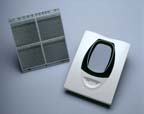
Fire Control Instruments
Ideal for use in applications with open areas and high ceilings, the BEAM1224 series reflective beam detectors are designed as a cost-effective alternative to traditional projected beam smoke detectors. Listed for operation from –22 to 131 deg. F, the detectors are suited for hostile environments where temperature extremes exceed the capabilities of spot-type detectors.Because of the temperature range, dealers and installers may find these devices useful for installations such as garages or warehouses. The series consists of a combination transmitter/receiver unit and a reflector, and includes four standard-sensitivity selections and two Acclimate settings.
The company has designed the series for a one-person installation with an optical sight and two-digit signal strength meter incorporated in the product to aid the process. To help meet the annual maintenance and test requirements of NFPA 72, FCI’s BEAM1224S model features an integral sensitivity test feature.

Fire-Lite Alarms
For applications where smoldering fires are anticipated, Fire-Lite Alarms offers the SD355 and SD355T photoelectric detectors. Both ULC listed, the addressable detectors use a sensing chamber with communications to provide open-area protection. The SD355T model has thermal sensors that will alarm at 135-deg. F. Dealers and installers can add optional remote LED annunciator capability.
What the customer had to say:
Todd Leggett, senior vice president of Sonitrol Corp., Berwyn, Pa., says the reason his company uses Fire-Lite products is the quality and service. “They offer a high-quality product and have an excellent training schematic,†Leggett emphasizes. Fire-Lite’s staff is willing to help Sonitrol with sales and by going on sales calls, which is a big plus, according to Leggett.
Installation is another reason Sonitrol uses the company. “We’ve never had trouble with the installation of a Fire-Lite product,†Leggett insists. In addition to the customer service, quality of the products and trouble-free installation, Fire-Lite private labels some of its products for Sonitrol. “We have a nice, tightly knit partnership,†Leggett says.
“We like the Fire-Lite infrastructure, and we like the total relationship we have with them.†–Todd Leggett, senior vice president, Sonitrol
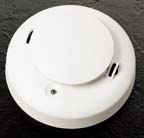
GE Infrastructure, Security
The ESL 500N series of smoke detectors have built-in sounders that make separate horn or siren installations unnecessary. A CleanMe feature lets users and installers know when the detector is dirty and in danger of causing false alarms.Field-replaceable optical chambers, dust compensation, multiple-criteria heat algorithms and self-diagnostics ease maintenance. Models are available in two- and four-wire configurations, and optional auxiliary relays and isolated heat sensors add to the products’ versatility. The 521NCSXT model features low current draw, making it compatible with a wide variety of control panels.
GE Security’s TS7 series of photoelectric smoke detectors feature self-diagnostic heads and field-replaceable optical chambers. Automatic drift compensation adjusts the alarm sensitivity when the detector is dirty. Six-inch bases support either two- or four-wire smoke detector heads. The TS7-2T and TS7-4T models include rate-of-rise and fixed-heat sensors for detection of flaming and smoldering fires and enhanced fire detection.
What the customer had to say:
Richard Cantor, CEO of Amerigard Alarm and Security Corp., New York, says his company uses GE Security products because of the manufacturer’s reputation and variety of products it offers. “It’s a wonderful company, and they’ve made a really strong financial investment in our industry,†Cantor insists. “There are a tremendous number of sophisticated devices to be used in the industry.
“[GE Security] brings a wonderful array of products to our company,†he declares. “One of the things we like is the superior quality and reliability of the products, which are very critical in a life safety application.â€
“[GE] products are high quality, they are reliable, and GE stands behind them.†–Richard Cantor, CEO, Amerigard Alarm and Security Corp.
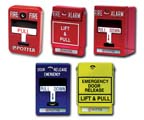
Potter Electric Signal Co.
Potter Electric Signal Co.’s line of manual pull stations are manufactured with corrosion-inhibited surfaces and are UL-, ULC-, CSFM- and FM-approved. The 10-amp, snap-action-switch pull stations have painted die cases and are fitted with 14-gauge plated steel back plates for single gang mounting. Various color availabilities make the pull stations conducive for special applications. Dual-action and weatherproof options further expand the line’s versatility in the market.
What the customer had to say:
Joel Shoemaker, owner of American Technology, Waukesha, Wis., chooses Potter Electric for several reasons. “One, the customer service is excellent,†he says. Shoemaker’s company needed quick training on the manufacturer’s fire alarm equipment, and Potter Electric stepped up to the plate. “We had a short window in which to be trained and they accommodated that,†he notes.
Another reason Shoemaker uses the company’s products is “ease-of use,†he declares. “The products are simple, and the backup or technical support has been excellent.â€
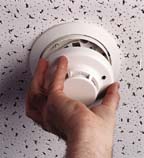
System Sensor
System Sensor’s 5600 series mechanical heat detectors consist of four single-circuit and four dual-circuit models. The models are available with fixed temperature or combination fixed/rate-of-rise sensors, and 135-deg. or 194-deg. temperature ratings. The design is similar to that of a smoke detector and is aesthetically pleasing. With this latest series comes more back-box mounting options and a reversible mounting bracket for flush- or surface-mount installations.The i3 series of photoelectric smoke detectors from System Sensor was designed for easy installation and instant inspection. For most applications, two-wire and four-wire detectors are available with or without fixed 135-deg. F thermal sensors. Installers may like the drift compensation feature and the plug-in design that permits pre-wiring.
The maintenance protocol, which prompts cleaning, also helps prevent false alarms caused by dirt or dust. Other features include an infrared sensitivity reader, a removal tool and retrofit adapter bracket, and a two-wire loop test/maintenance module, which allows any listed panel to communicate with the two-wire detectors.
What the customer had to say:
Bill Richardt, president of Richard Security, Syosset, N.Y., chooses System Sensor because he likes their entire line of products overall. “The pricing is reasonable, the products are consistent, and reliability is there,†Richardt says. His company finds System Sensor devices easy to install and troubleshoot. “We find them really easy to work with,†he adds.
“We find [System Sensor products] to be very consistent and reliable, and easy to work with.†–Bill Richardt, president, Richard Security
